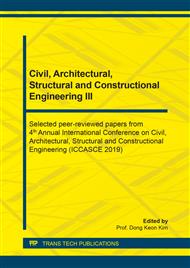p.111
p.117
p.124
p.129
p.137
p.142
p.147
p.152
p.157
Optimum Process of Pipeline Selection in Water Distribution Network: Case Study
Abstract:
This research deals with a case study of clear water rising pumping main to supply drinking water in Adityapur Municipality, Jharkhand, India. Pipes are important and most cost bearing entity in a water pipeline distribution network. Hence proper selection of pipe is most challenging job to pipeline designers. This study shows about various processes involved in order to get an optimum design in respect to the selection of pipes using WaterGEMS software. A 60 MLD Subarnarekha Water Supply Scheme (WSS) is been considered where two numbers 30 MLD pumps with 40 m rated head have been proposed on the basis of two working and two standby modes to fulfill the demand of drinking water. Mainly cost variation is compared due to change in pipe diameter in relation with energy cost against this WSS. As per the data received, the inputs were incorporated and accordingly the results are interpreted. The whole considered network consists 37 pipes and 10 junctions. Various system outputs are been reflected for steady state simulations. An extended period simulation has also been carried out to compute filling time of all tanks according to their water demands. The pumping energy cost comparison is also reflected when a 1200 mm diameter of pipeline is been replaced with 1000 mm pipeline that runs for 4.173 km. This study is an effort to open up the process of cost optimization in pressure pipeline network for implementation in various water supply schemes.
Info:
Periodical:
Pages:
137-141
Citation:
Online since:
April 2020
Authors:
Price:
Сopyright:
© 2020 Trans Tech Publications Ltd. All Rights Reserved
Share:
Citation:


